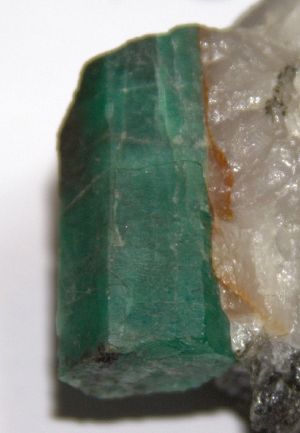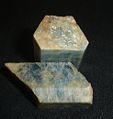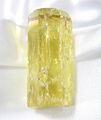Beryl
- For other uses, see Beryl (disambiguation).

The mineral beryl is a beryllium aluminium cyclosilicate with the chemical formula Be3Al2(SiO3)6. The hexagonal crystals of beryl may be very small or range to several meters in size. Terminated crystals are relatively rare. Beryl exhibits conchoidal fracture, has a hardness of 7.5-8, a specific gravity of 2.63-2.80. It has a vitreous luster and can be transparent or translucent. Its cleavage is poor basal and its habit is dihexagonal bipyramidal. Pure beryl is colorless, but it is frequently tinted by impurities; possible colors are green, blue, yellow, red, and white. The name comes from the Greek beryllos for the precious blue-green color of sea water.
Varieties
Varieties of beryl have been considered gemstones since prehistoric times. Recognized for its beauty, in the Bible, in Ezekiel 1:16, the wheels of God's throne is described as having the appearance of "gleaming beryl". Green beryl is called emerald, red beryl is bixbite or red emerald or scarlet emerald, blue beryl is aquamarine, pink beryl is morganite, white beryl is goshenite, and a clear bright yellow beryl is called golden beryl. Other shades such as yellow-green for heliodor and honey yellow are common. Red beryl is extremely rare and is not used in jewelry as the crystals it forms are very small. Blue beryl (aquamarine) when exposed to sunlight will fade in color.
Deposits
Beryl is found most commonly in granitic pegmatites, but also occurs in mica schists in the Ural Mountains and is often associated with tin and tungsten orebodies. Beryl is found in certain European countries such as Austria, Germany, and Ireland. It also occurs in Madagascar (especially morganite).
The most famous source of emeralds in the world is at Muzo and Chivor, Boyacá, Colombia, where they make a unique appearance in limestone. Emeralds are also found in the Transvaal, South Africa, Minas Gerais, Brazil, and near Mursinka in Urals. In the United States emeralds are found in North Carolina. New England's pegmatites have produced some of the largest beryls found, including one massive crystal with dimensions 5.5 m by 1.2 m (18 ft by 4 ft) with a mass of around 18 metric tons. Other beryl locations include South Dakota, Colorado, Utah, Idaho, and California.
Applications
Massive beryl is a primary ore of the metal beryllium.
The druids used beryl for scrying, while the Scottish called them “stones of power”. The earliest crystal balls were made from beryl, later being replaced by rock crystal.
Beryl var. emerald.
Beryl var. aquamarine, Brazil
Beryl made in Tajikistan
- Pierre-img 0592.jpg
Morganite
References and external links
- Sinkankas, John, 1994, Emerald & Other Beryls, Geoscience Press, ISBN 0-8019-7114-4
- Hurlbut, Cornelius S.; Klein, Cornelis, 1985, Manual of Mineralogy, 20th ed., John Wiley and Sons, New York ISBN 0-471-80580-7
- Minerals.net
- Webmineral.com
- Gems Explained
- Mineral Galleries
See also
- List of minerals
cs:Beryl de:Beryll es:Berilo fr:Béryl hr:Beril it:Berillo he:בריל lv:Berils lt:Berilas nl:Beryl ja:緑柱石 pl:Beryl (minerał) pt:Berilo ru:Берилл sk:Beryl fi:Berylli sv:Beryll tr:Beril uk:Берил





